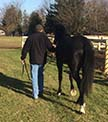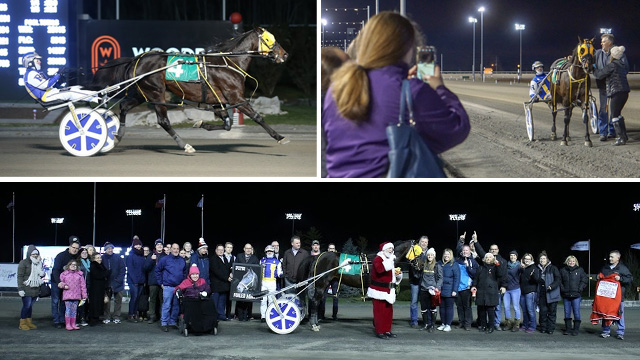It is, possible

On the night of December 22, my son and I traveled to a chilly Woodbine Mohawk Park to help give the mighty Foiled Again a proper Canadian 'Thank you.'
On a cold night in December, just a few nights before Christmas, we weren't certain as to how many people would attend, and were pleased to see the parking lot quite full upon our arrival.
We sat and watched a few races inside the bustling grandstand, but would head out onto the tarmac when the contestants post-paraded for the 6th race - The Foiled Again Farewell Pace.
There were dozens of people outside as anticipation for the race built, and it definitely created a bit of a racetrack atmosphere. My eyes stayed focused on the track however, and mainly on the star of the show. He had been a mainstay of North American racing forever, and it wasn't lost on me that this would be the final time that I'd get to see him perform live.
As the race unfolded, and Louis Roy and Foiled Again took the lead coming for home, I started to clap and cheer as the pair approached deep stretch - but I was far from alone. The roar from the crowd got louder and louder as the champion hit the wire first, and as I turned my head I saw that there were literally hundreds of people on the tarmac by now, and at least a quarter of them, if not more, were younger than Foiled Again himself. Children - everywhere! Cheering, and clapping, and jumping up-and-down, for a horse that had been racing long before most of them were born.

It really was a great moment. And it was a moment that got me thinking about our future as a spectator sport. Fans and new participants are out there, both young and old, and we just have to keep working on finding them. And when I say "we" I'm talking about you, and about me, and about everyone in our game.
There has always been a bit of a disconnect in racing when it comes to whose job it is to do what. The horsepeople work endless hours to provide the product. The racetracks provide the facilities. Whose job is it to market the sport and attract the crowds though?
I think it's time to get past all of that. Time for every one of us, as individuals, and as groups, to take responsibility for the future of our sport. Time to look in the mirror. Why does it matter who attracts new fans and owners, as long as we just do it?
Between the hard copy publication of this magazine, and its appearance online, approximately 10,000 people will read this column. What if every single one of these people made an honest effort, in 2019 alone, to attract just one new person to harness racing? Ask a few members from your golf club if they'd like to buy 5% of a horse? Invite a family from your child's soccer team to spend a night at the races - and if they enjoy themselves, possibly explain horse ownership to them? Run a North America Cup pool at your office? Bring your neighbour and their kids to the farm on a Saturday morning to watch your horses train? Ask 3 or 4 old high school buddies to go in on 10% of a yearling? The possibilities are endless.
Personally, I added one new owner to our industry (a person who was already a fan) in 2018, and I have a good friend from high school interested in coming in on a yearling this fall. I don't want accolades for this - I just want our sport to thrive and succeed into the future.
Should racetracks, and horseman's associations, and other industry groups all try to market our sport? Absolutely they should. But that doesn't mean the rest of us should just wait for the person beside us to do it. We're all in this together. It is, possible, to grow our fan and participant base just one person at a time. As they say, 'It takes a village.'
The math isn't tough. If 10,000 of us make the effort to bring in just one new person each, and only 3 in 10 are successful, we can still possibly add 3,000 new fans, or owners, or caretakers. Who knows?
The math isn't tough. If none of us try, we add no one.
Dan Fisher
[email protected]


